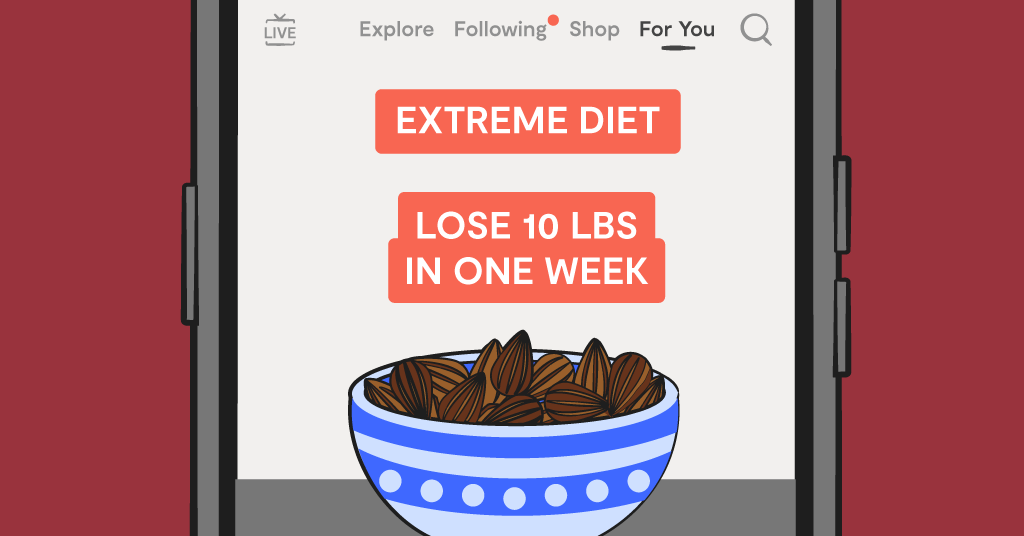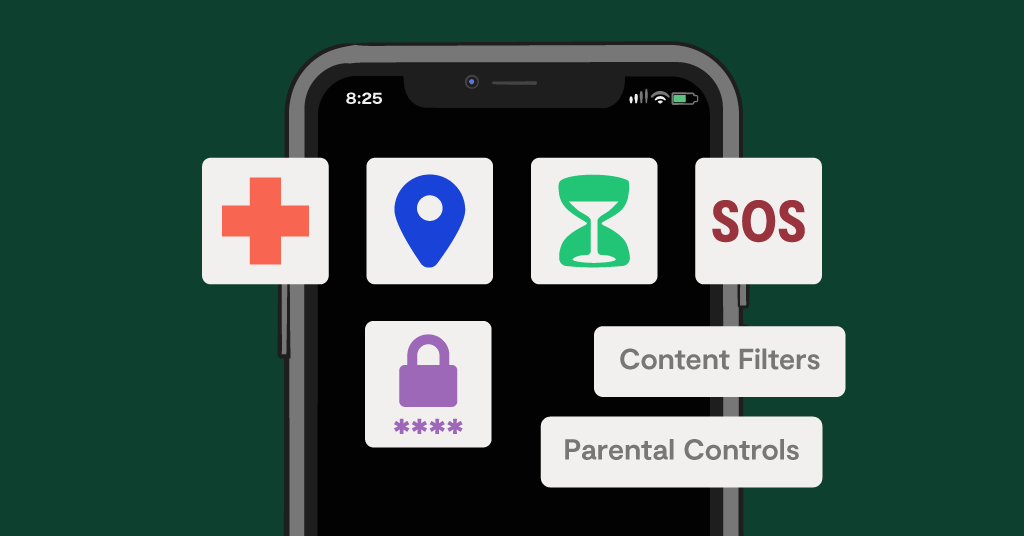**This blog post was updated on March 2, 2023.**
Content warning: This article discusses eating disorders and contains language that may be triggering to some readers.
It probably comes as no surprise to you that social media and eating disorders are often connected. After all, it’s nearly impossible to browse Instagram without seeing an ad for a “skinny detox tea” or scroll through Facebook without stumbling upon someone’s before-and-after weight loss photos. But what you may not realize is that TikTok — known for its expressive dance moves, silly comedy sketches, and videos of dogs snuggling with newborn babies — also hosts a shocking amount of content promoting disordered eating.
Here’s how it works. If TikTok thinks you’ll like videos of people renovating their kitchens, they’ll start to slowly add those into your feed of recommended videos (called the “For You” page). Great! you might think. I’ll get exactly what I want! But what if TikTok thinks you have bulimia? Or binge eating disorder? Or orthorexia? Then, the platform will show you videos about eating disorders. If you’re a child, these short videos can have an incredibly damaging — and potentially even fatal — effect over time.
While the algorithm for the For You page is “intelligent” enough to guess things about you that you may have never said out loud, it’s far from emotionally intelligent. There’s no way for it to understand the harm it can cause by serving content that might encourage disordered eating.
Not all eating disorder-related content on TikTok is harmful, of course. In fact, some struggling teens may find recovery videos from other kids their age incredibly supportive and empowering. But it’s difficult — perhaps impossible — to “train” your For You page to only serve you TikToks that actively discourage disordered behaviors, rather than suggest that you practice them.
What TikTok Is — and Isn’t — Doing to Help
TikTok’s community guidelines prohibit “content that supports pro-ana or other dangerous behavior to lose weight,” and the platform has made some attempts to help regulate content that promotes disordered eating. In practice, however, enforcement of this guideline appears to be as simple as hiding some videos that use explicit pro-eating disorder hashtags. Even still, searching “ProAna” (pro-anorexia), “EdCheck” (eating disorder check), and “EdChallenge” (eating disorder challenge) will show you users and videos in support of disordered eating.
Kids who are actively seeking out content promoting eating disorders can get around controls faster than platforms can create them. For example, instead of searching for “EatingDisorder,” which contains almost no videos, a child can simply tweak the spelling and find themselves in an endless scroll of potentially damaging content. On TikTok, videos tagged with “EatingDisoder” have 118.5 million views. “EatingDissorder” has 71.2 million views. “EatingDesorder” has two million views. The platform’s few protections are doing little to address the problem.
Other platforms are more proactive with their regulations. If, for example, you type “ProAna” into Tumblr — a social media site that has a long history of hosting content promoting disordered eating — the platform sends you to a page that asks, “Everything okay?” and offers a list of resources that can help.
Not only does TikTok fail to provide this kind of assistance, but it is also unable to control the less direct forms of pro-disordered eating content. “Prom Queen” is a song that has been used more than 50,000 times on the platform, and it includes lyrics like, “Shut up, count your calories / I never looked good in mom jeans.” One of the most prominent young TikTok stars also shared it with an energetic dance and a megawatt smile to promote a giveaway to her tens of millions of followers in a since-deleted rendition of the song.
It’s clear that social media is rife with dangerous content, even if that content isn’t created with the purpose of causing harm. It may seem like just a happy dance on the surface, but lines like “I've been starving myself / Carving skin until my bones are showing” can really trigger disordered thoughts and behaviors — especially in young, impressionable viewers.
A Parent’s Guide to Social Media and Eating Disorders
To learn more about how families should respond to these pressures, we spoke with Ashley Scott, assistant program director at Walden Behavioral Care, an eating disorder treatment center, about what parents and guardians should know about social media and eating disorders. “We know that adolescent brains aren’t fully developed, so they are even more susceptible to influence,” she says. “When a child is exposed to eating disorder-related content, it can spark the urge to engage in new behaviors or to ‘perfect’ their existing behaviors.”
Whether or not your child is already experiencing an eating disorder, it’s important to not underestimate the power of peer influence when it comes to eating disorders. Scott says many of the clients in her program are in treatment because of something they saw a friend doing or something they encountered online. Keeping an eye out for your child’s physical and mental health can help you recognize when they may be struggling.
Potential signs of an eating disorder
You might assume that everyone with an eating disorder is either purging or restricting their intake in order to make themselves look a certain way — but that is only sometimes the case. “Eating disorders don’t look like anything,” Scott points out. “They are extremely secretive, often due to shame, which can make them difficult to detect.” It’s best not to base your judgment about whether your child has an eating disorder solely on things like weight fluctuations. That being said, there are still a number of signs you can look for if you’re concerned your child might have an eating disorder.
- Sudden mood changes. Teens and tweens experience hormone fluctuations, so some degree of mood variation is common. But if your kid just isn’t acting like themselves, take time to chat with them about what they’re feeling.
- Sudden dietary shifts. “Any sudden shifts to a gluten-free or dairy-free diet, or a switch to vegetarianism or veganism that seems out of the blue would be something to note,” Scott says.
- Worse school performance. If your child usually gets great grades but suddenly starts failing assignments, it’s probably time to check in with them.
- Different mealtime habits. According to Scott, “If a child is excusing themselves from the dinner table immediately after meals and spending longer amounts of time in the bathroom, this could be a sign of purging.”
How to Encourage a Healthy Food–Body Relationship
If your child is experiencing an eating disorder, they can feel very scared and alone, so make sure you’re consistently reminding them that they can always talk to you. “If a judgment-free zone can be developed around food and body, it allows kids to feel comfortable asking for help — their eating disorder will be fighting hard to prevent this from happening,” Scott explains.
You can also help by being very intentional about the way you talk about food. For example, make sure not to describe foods in terms of morality — calling chocolate a “bad food” and kale a “good food.” Instead, remind your child that it’s great for them to explore new flavors and to listen to their body’s wants and needs.
The way you talk about your own body can also have an impact on your child’s view of themselves. “Practice body acceptance, even if that means doing your own work to feel comfortable in the body you have,” Scott recommends. “For example, don’t keep a scale readily available in the home and don’t weigh yourself or talk about your weight in front of your children.” Instead, talk about how kind your child is to their friends or how cool it is that they’re able to do a backflip on the trampoline.
Just remember that while not every eating disorder is tied to body image, there is no downside to encouraging your kid to have a positive relationship with their body, so be proactive about doing so — it can go a long way in negating the connection between social media and eating disorders.
Get Your Child Help When They Need It
If you notice some signs that your child might have an eating disorder, be sure you seek professional help for them. “We highly recommend having an intake assessment completed through an eating disorder facility in your area,” Scott says. “Eating disorders are the deadliest of all psychiatric illnesses, and they can grow rapidly. An assessment should be seen as gathering data and information to be sure that your child is safe.”
Bark can also help by alerting you to potential signs of body image or eating disorder concerns in your child’s online activities and can let you set screen time limits for TikTok and other social media platforms to reduce the connection between social media and eating disorders. If this is something your child might be experiencing, we’ll provide expert-recommended steps for talking with them about what’s happening. Above all, make sure your child knows they can always come to you if they need help, and stay attuned to their mental health so you can check in when there might be a problem.
If you or someone you care about is struggling with an eating disorder, call the National Eating Disorders Association’s hotline at 800-931-2237. You can also text 800-931-2237 or chat with a trained volunteer online. For more information use these helpful resources.
Read more
Bark helps families manage and protect their children’s digital lives.






